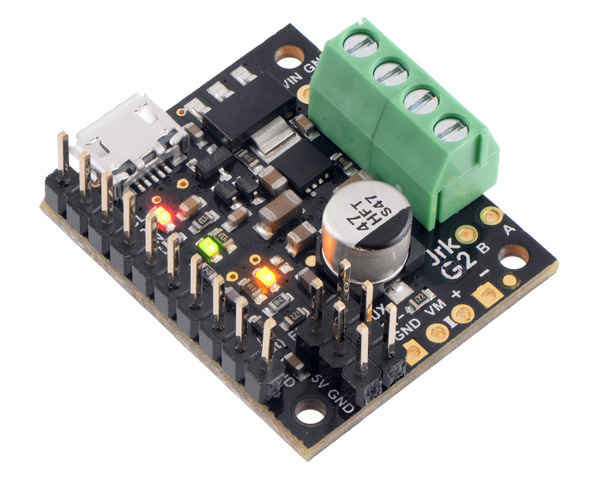

This is a merged information page for Item #3143.
View normal product page.
Pololu item #:
3143
Brand:
Pololu
Status:
Active and Preferred

This compact motor controller makes closed-loop speed or position (but not both!) control of a brushed DC motor easy, with quick configuration over USB using our free software. It supports five control interfaces: USB, TTL serial, I²C, analog voltage (potentiometer), and hobby radio control (RC). This version offers a 4.5 V to 28 V operating range and can deliver continuous output currents up to 2.6 A (5 A peak) without a heat sink. This version ships with soldered header pins and terminal blocks.
Alternatives available with variations in these parameter(s): version Select variant…
 Compare all products in Pololu Jrk Motor Controllers with Feedback or
Compare all products in Pololu Jrk Motor Controllers with Feedback or  Pololu Jrk G2 Motor Controllers with Feedback.
Pololu Jrk G2 Motor Controllers with Feedback.
 |
Jrk G2 21v3 USB Motor Controller with Feedback (Connectors Soldered). |
|---|
 |
Jrk G2 21v3 USB Motor Controller with Feedback (Connectors Soldered), top view. |
|---|
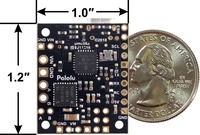 |
Jrk G2 21v3 USB Motor Controller with Feedback, bottom view with dimensions. |
|---|
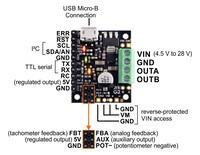 |
Basic pinout diagram of the Jrk G2 21v3 USB Motor Controller with Feedback (Connectors Soldered). |
|---|
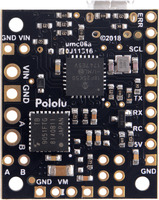 |
Jrk G2 21v3 USB Motor Controller with Feedback, bottom view. |
|---|
 |
Comparison of the newer Jrk G2 21v3 (black PCB) with the original Jrk 21v3 (green PCB). |
|---|
 |
Side-by-side comparison of the different Jrk G2 USB Motor Controllers with Feedback. |
|---|
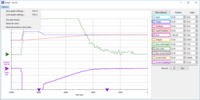 |
The graph window in the Jrk G2 Configuration Utility (version 1.2.0). |
|---|
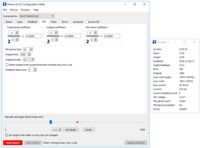 |
The main window and the variables window in the Jrk G2 Configuration Utility (version 1.2.0). |
|---|
With integrated support for analog voltage or tachometer (frequency) feedback, the second-generation G2 family of Jrk motor controllers makes it easy to add closed-loop control of speed or position (but not both!) of a single brushed DC motor to a variety of projects. These versatile, general-purpose modules support five different control interfaces: USB for direct connection to a computer, TTL serial and I²C for use with a microcontroller, RC hobby servo pulses for use in an RC system, and analog voltages for use with a potentiometer or analog joystick. They also offer many settings that can be configured using our free configuration software utility for Windows, Linux, and macOS. This software simplifies initial setup of the device and allows for in-system testing and monitoring of the controller via USB (a micro-B USB cable is required to connect the Jrk G2 to a computer).
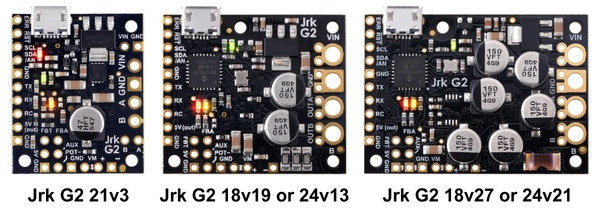 |
The table below lists the members of the Jrk family, including the original (green) versions, and shows the key differences among them.
 Jrk 21v3 |
 Jrk G2 21v3 |
 Jrk G2 18v19 |
 Jrk G2 24v13 |
 Jrk G2 18v27 |
 Jrk G2 24v21 |
|
|---|---|---|---|---|---|---|
| Recommended max operating voltage: |
28 V(1) | 28 V(1) | 24 V(2) | 34 V(3) | 24 V(2) | 34 V(3) |
| Max nominal battery voltage: |
24 V | 24 V | 18 V | 28 V | 18 V | 28 V |
| Max continuous current (no additional cooling): |
2.5 A* | 2.6 A | 19 A | 13 A | 27 A | 21 A |
| USB, TTL serial, Analog, RC control: |
 |
 |
 |
 |
 |
 |
| I²C control: |  |
 |
 |
 |
 |
|
| Hardware current limiting: |  |
 |
 |
 |
||
| Dimensions: | 1.35″ × 1.35″ | 1.0″ × 1.2″ | 1.4″ × 1.2″ | 1.7″ × 1.2″ | ||
| Price: | $74.95 | $54.95 | $109.95 | $109.95 | $149.95 | $149.95 |
| 1 Transient operation (< 500 ms) up to 40 V. 2 30 V absolute max. 3 40 V absolute max. * Reduced from “3 A” based on newer, more stringent tests. The value now is directly comparable to the rating for the newer G2 21v3. |
||||||
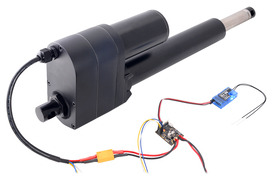 |
Pololu Jrk G2 18v19 USB Motor Controller with Feedback controlling an industrial-duty linear actuator with an RC receiver. |
|---|
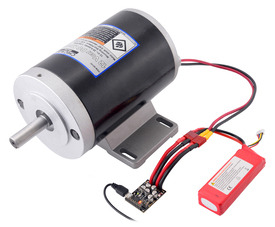 |
Pololu Jrk G2 18v27 USB Motor Controller with Feedback controlling a high-power motor from USB. |
|---|
 |
The Jrk G2 21v3 operates from 4.5 V to 28 V and can deliver a continuous output current of 2.6 A (5 A peak) without a heat sink. The controller supports transient operation (< 500 ms) up to 40 V, and the maximum recommended nominal battery voltage is 24 V. This version is sold with connectors soldered, so no soldering is necessary to use it.
|
|
A version is also available with header pins and terminal blocks included but not soldered, which allows for custom installations.
The Jrk G2 family features a number of improvements compared to our original two Jrk motor controllers (21v3 and 12v12). Most importantly, the Jrk G2 controllers support both higher operating voltages and larger output currents while being even more compact than their predecessors. Other new features include:
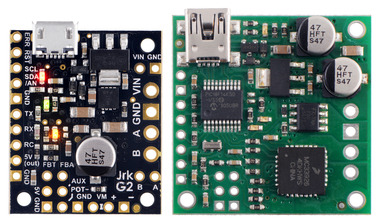 |
Comparison of the newer Jrk G2 21v3 (black PCB) with the original Jrk 21v3 (green PCB). |
|---|
The Jrk G2 controllers are not drop-in replacements for the original Jrk controllers because of differences in their form factors and pin arrangements, although wiring changes should be straightforward. The Jrk G2 serial protocol is compatible with (and generally a superset of) the original Jrk serial protocol, so in many cases, serial interface software running on a microcontroller or computer will not need to be modified to work with a Jrk G2.
| Size: | 1.2″ × 1.0″ × 0.47″ |
|---|---|
| Weight: | 7.5 g |
| Motor channels: | 1 |
|---|---|
| Control interface: |
USB; non-inverted TTL serial; I²C; RC servo pulses; analog voltage |
| Minimum operating voltage: | 4.5 V1 |
| Maximum operating voltage: | 28 V2 |
| Continuous output current per channel: | 2.6 A3 |
| Maximum PWM frequency: | 20 kHz |
| Reverse voltage protection?: | Y |
| Version: | G2 21v3 (28 V max, 2.6 A max continuous) |
| Connectors soldered?: | Y |
| PCB dev codes: | umc06a |
|---|---|
| Other PCB markings: | 0J11316 |
User’s manual for the Pololu Jrk G2 USB Motor Controllers with Feedback.
This DXF drawing shows the locations of all of the board’s holes.
This DXF drawing shows the locations of all of the board’s holes.
This DXF drawing shows the locations of all of the board’s holes.
This is a library for the Arduino IDE that helps interface with a Jrk G2 USB Motor Controller with Feedback using serial or I²C.
This repository contains the source code of the Pololu Jrk G2 Configuration Utility (jrk2gui) and the Pololu Jrk G2 Command-line Utility (jrk2cmd). It also has drivers for Windows and build instructions.
We’ve expanded our line of Glideforce Light-Duty Linear Actuators to now include options with a 10:1 gear ratio. As you might know if you are a long...
Our Jrk G2 family is growing! Today we released the Jrk G2 21v3 USB Motor Controller with Feedback, which you can think of as the baby version of...